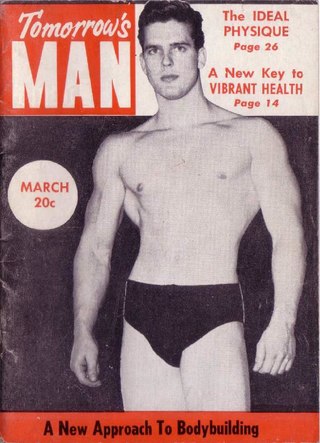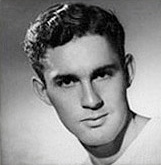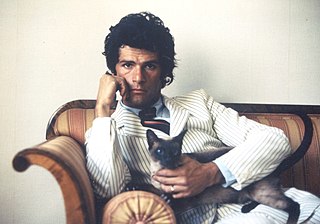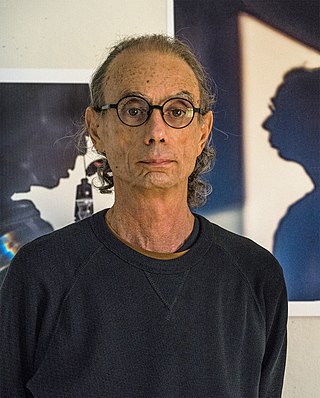
Robert Michael Mapplethorpe was an American photographer, best known for his black-and-white photographs. His work featured an array of subjects, including celebrity portraits, male and female nudes, self-portraits, and still-life images. His most controversial works documented and examined the gay male BDSM subculture of New York City in the late 1960s and early 1970s.
The Athletic Model Guild, or AMG, was a physique photography studio founded by Bob Mizer in December 1945. During those post-war years, United States censorship laws allowed women, but not men, to appear in various states of undress in what were referred to as "art photographs". Mizer began his business by taking pictures of men that he knew. His subjects would often pose for pictures which illustrated fitness tips and the like, but were also viewed as homoerotic material.
Bruce Harry Bellas was an American photographer. He was influential in his work with male physiques and nudes. Bellas was well known under the pseudonym Bruce of Los Angeles.
Jacqueline Louise Livingston was an American photographer known for her work exploring woman's role as artist and person and investigating the boundaries of intimacy and propriety.
Armin Hagen Freiherr von Hoyningen-Huene is a German-American photographer, artist, filmmaker, clothing designer/sewer, and model best known by his stage name Peter Berlin. In the early to mid-1970s.

Jim French was an American artist, illustrator, photographer, filmmaker, and publisher. He is best known for his association with Colt Studio which he, using the pseudonym Rip Colt, created in late 1967. Thomas parted from the endeavor in 1974 leaving French to continue to build what would become one of the most successful gay male erotica companies in the U.S.

Physique magazines or beefcake magazines were magazines devoted to physique photography — that is, photographs of muscular "beefcake" men – typically young and attractive – in athletic poses, usually in revealing, minimal clothing. During their heyday in North America in the 1950s to 1960s, they were presented as magazines dedicated to fitness, health, and bodybuilding, with the models often shown demonstrating exercises or the results of their regimens, or as artistic reference material. However, their unstated primary purpose was erotic imagery, primarily created by and for gay men at a time when homosexuality was the subject of cultural taboos and government censorship.

Henning von Berg is a former German civil engineer who became a portrait photographer. His specialty is character portraits and fine art nudes.

Nude photography is the creation of any photograph which contains an image of a nude or semi-nude person, or an image suggestive of nudity. Nude photography is undertaken for a variety of purposes, including educational uses, commercial applications and artistic creations.

Philip Gefter is an American author and photography historian. His books include Cocktails with George and Martha: Movies, Marriage, and the Making of Who's Afraid of Virginia Woolf?; What Becomes A Legend Most, the biography of Richard Avedon; and Wagstaff: Before and After Mapplethorpe, the biography of Sam Wagstaff, for which he received the 2014 Marfield Prize, the national award for arts writing. He is also the author of George Dureau: The Photographs, and Photography After Frank, a book of essays published by Aperture in 2009. He was on staff at The New York Times for over fifteen years, where he wrote regularly about photography. He produced the 2011 documentary film, Bill Cunningham New York.

Albert J. Urban, Jr. (1917-1992) was an American physique photographer. His work appeared widely in physical culture and physique magazines of the 1940s and 1950s. Scholar Thomas Waugh described Urban as one of the "pillars of the postwar golden age of gay physique culture".

Robert Henry Mizer was an American photographer and filmmaker, known for pushing boundaries of depicting male homoerotic content with his work in the mid 20th century.

Fine art nude photography is a genre of fine-art photography which depicts the nude human body with an emphasis on form, composition, emotional content, and other aesthetic qualities. The nude has been a prominent subject of photography since its invention, and played an important role in establishing photography as a fine art medium. The distinction between fine art photography and other subgenres is not absolute, but there are certain defining characteristics.

Victor Arimondi was an Italian American photographer and model who lived and worked in Europe before moving to the United States in the late 1970s. His early fashion photography, his portraits of Grace Jones and other artists, and his male nudes photographed in New York and San Francisco captured the pre-AIDS culture of the 1970s and early 1980s.

David Lebe is an American photographer. He is best known for his experimental images using techniques such as pinhole cameras, hand-painted photographs, photograms, and light drawings. Many of his photographs explore issues of gay identity, homoeroticism, and living with AIDS, linking his work to that of contemporaries such as Robert Mapplethorpe, Peter Hujar, and David Wojnarowicz. Though his style and approach set him apart from these contemporaries, "Lebe is now incontrovertibly part of the history of twentieth-century queer artists."

Physique Pictorial is an American magazine, one of the leading beefcake magazines of the mid-20th century. During its run from 1951 to 1990 as a quarterly publication, it exemplified the use of bodybuilding culture and classical art figure posing, as a cover for homoerotic male images, and to evade charges of obscenity.

Grecian Guild Pictorial was an American physique magazine published from 1955 until 1968. While ostensibly dedicated to art, health, and exercise, like other physique magazines of the time, it was understood that, in practice, its homoerotic photography and illustrations were almost exclusively created by and for gay men. It differed from other physique magazines in its focus on themes and imagery from Ancient Greece, which was seen by many as a coded reference to homosexuality. It has been described as one of the "gayer" of the physique magazines.

Physique photography is a tradition of photography of nude or semi-nude men which was largely popular between the early 20th century and the 1960s. Physique photography originated with the physical culture and bodybuilding movements of the early 20th century, but was gradually co-opted by homosexual producers and consumers, who favoured increasingly homoerotic content. The practiced reached its height in the 1950s and early 1960s with the inception of physique magazines, which existed largely to showcase physique photographs and were widely consumed by a mostly-gay audience.
John S. Barrington (1920–1991) was a British physique photographer and publisher. Barrington's photos of nude or semi-nude men appeared widely in British and American physique magazines, sometimes under the pseudonym John Paignton. Barrington published many of his own physique magazines, including Male Model Monthly, the first in Britain. He also published a number of books related to photography and anthropometry. Barrington was a prolific artist and publisher, and by 1984 was said to have published more nude titles than any other individual in Europe or the United States.

Russ Warner (1917–2004) was an American physique photographer. His photographs of bodybuilders appeared widely in physique and bodybuilding magazines of the 1950s and 1960s. His photography studio was initially located in Oakland California; he later relocated to the Los Angeles area.

















